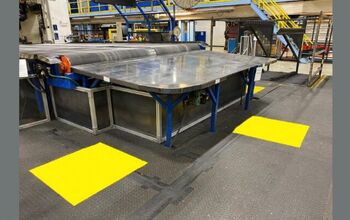Alfa Romeo Giulia and Stelvio Recalled for Brake Snafu

Many years of competing in demolition derbies taught me many things, such as the value of not looking over my shoulder while reversing into someone at a high rate of speed and the importance of a good neck brace. I also learned that while one can substitute other liquids for transmission fluid, braking systems don’t play well with any pollutant that’s not designed to be in there.
Alfa Romeo has also discovered this fact, and is now recalling a total of 307 Giulia sedans and Stelvio crossovers from the 2018 model year for potentially contaminated brake fluid.
As detailed by the NHTSA, certain Giulias and Stelvios may contain brake fluid that was contaminated in the assembly plant with a non-compatible oil type. On November 23, two vehicles within the plant failed the dynamic Customer Product Audit quality test when they experienced a loss of clutch pressure. FCA says the entire yard was subsequently placed on hold as a safety measure.
Five days later, Alfa Romeo opened an investigation into the loss of clutch pedal pressure due to QC failure of those two subject vehicles. The same day, the boffins at Alfa donned white coats and conducted laboratory analysis on the vehicles that failed QC. This revealed contamination of the brake and clutch fluid with mineral oil. Further investigation found that a pallet containing those three fluids was used starting November 13th.
The next day, all vehicles were held at the assembly plant, with suspect vehicles tested for oil contamination. On December 5th, the plant created a system in which vehicles would be assembled using brake and clutch fluid from barrels they knew to be uncontaminated. Using date codes and a bit of math, Alfa determined 307 Giulias and Stelvios were built during the time frame in question.
What happens when brake fluid is polluted? Well, the brake system components contaminated with non-compatible oil may become damaged and braking performance may suffer. Vehicles with contaminated brake fluid may experience decreased braking performance when depressing the brake pedal. In certain cases, it can cause a system failure with little warning, leading to a vehicle crash.
Alfa Romeo will notify owners, and dealers will inspect the braking system, replacing it as necessary, free of charge. The recall is expected to begin February 8, 2018. Owners may contact Alfa Romeo customer service at 1-844-253-2872. Chrysler’s number for this recall is T84.
[Image: Fiat Chrysler Automobiles]

Matthew buys, sells, fixes, & races cars. As a human index of auto & auction knowledge, he is fond of making money and offering loud opinions.
More by Matthew Guy
Latest Car Reviews
Read moreLatest Product Reviews
Read moreRecent Comments
- Jeff Arthur Dailey--If you really want to see a similarity between Chevy and Cadillac look at the 71 Chevy Caprice compared to the 71 Cadillac Deville more similar in looks than the 61s. Motor Trend even had an article comparing them and stating that you could buy a comparably equipped 71 Caprice and save thousands. The 1971 Chevrolet Caprice/Impala: Value-Priced, Cadillac ... YouTube · Rare Classic Cars & Automotive History 16 minutes, 53 seconds Feb 3, 2024
- Buickman mostly cut and paste information. where is Jack Baruth when you need him?
- ToolGuy In a perfect world (we don't have that), and a stable world (also no), one might expect the used EV pricing curve to follow the new EV pricing curve but with a lag. Overall that might be sort of what we are seeing but I will have to noodle on it more. (I know you can't wait.)
- ToolGuy Ok after listening to the podcast (and re-listening to the relevant part while doing a painting job in the hot sun, won't make any significant pronouncements at this point) I was curious about the methodology. ¶ Here you go: "Methodology iSeeCars analyzed over 2.2 million 1- to 5-year-old used cars sold in May 2023 and 2024. The average listing prices of each car model were compared between the two time periods, and the differences were expressed as both a percentage difference from the 2023 price as well as a dollar difference. Heavy-duty vehicles, low-volume vehicles, vehicles discontinued as of the 2023 model year, and vehicles in production for fewer than four of the last five model years for each period were excluded from further analysis." ¶ So for any specific model, you have age and mileage and condition factoring in (think of the volume curve for 'new' models over the past 5 years). ¶ The overall averages have a -lot- of model mix going on. ¶ Random question: is the 'listing price' the listing price (likely) or the actual transaction price? (It matters if the listing prices were too optimistic a year ago, i.e., some of the 'drop' would represent more realism in the listing prices.)
- Johnny ringo VinFast? The name sounds like some kind of a sports drink to me. The early reviews of their vehicles were absolutely terrible. The last vehicle I am going to buy is from a no-name company without any kind of reputation behind it. This reminds me of the Yugo-that was certainly successful.

































Comments
Join the conversation
Powdered Stelvio really sweetens up a cup of tea, and adds very few calories. Draining the brake fluid is highly recommended before making Stelvio powder.
Lucky for the US Alfas don't have clutches, then.